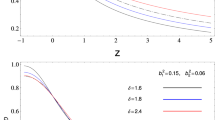Abstract
We work with the holographic model of interacting dark sector (dark energy plus dark matter) of the universe. The generalized Chaplygin gas model is taken as a Dark Energy (DE) candidate, and it interacts with Cold Dark Matter (CDM) in the framework of linear plus quadratic equation of state (EoS) parameter. We study the effect of interaction on the thermodynamics of the universe. Three interaction parameters of DE-CDM are considered: ΓρDE, ΓρDM, and Γ(ρDE + ρDM). We derive the corresponding effective equation of states for these different interaction parameters and analyze the behaviors of the derivative of entropies for DE, CDM and the apparent horizon, which is considered as a boundary of the universe. For this purpose the Generalized Second Law (GSL) of thermodynamics is used in the Friedman- Robertson-Walker (FRW) space to analyze the effect of quadratic terms on the thermodynamics of the universe, and the results are analyzed and compared with the solution for the linear form given in the literature.
Similar content being viewed by others
References
A. G. Riess et al., “Observational evidence from supernovae for an accelerating universe and a cosmological constant,” Astron. J. 116, 1009 (1998).
S. Perlmutter et al., “Measurements of Ω and Λ from 42 high-redshift supernovae,” Astroph. J. 517, 565 (1999).
C. H. Lineweaver, “Cosmological parameters,” arXiv: ph/0112381.
P. J. E. Peebles, and B. Ratra, “The cosmological constant and dark energy,” Rev. Mod. Phys. 75, 559 (2001).
T. Padmanabhan, “Cosmological constant, the weight of the vacuum,” Phys. Rep. 380, 235 (2003).
B. Feng, W. Xiulian, and Z. Xinmin, “Dark energy constraints from the cosmic age and supernovae,” Phys. Rev. B 607, 35 (2005).
Y. F. Cai, E. N. Saridakis, M. R. Setare, and J. Q. Xia, “Quintom cosmology: theoretical implications and observations,” Phys. Rep. 493, 1 (2010).
G. Caldera-Cabral, M. Roy, and L. A. Urea˜ -Lo´ pez, “Dynamics of interacting dark energy,” Phys. Rev. D 79, 063518 (2009).
A. Kamenshchik, M. Ugo, and P. Vincent, “An alternative to quintessence,” Phys. Lett. B 265, 511 (2001).
S. Wang, W. Yi, and L. Miao, “Holographic dark energy,” arXiv: 1612. 00345. to appear in Phys. Rep.
B. Wang, G. Yungui, and A. Elcio, “Transition of the dark energy equation of state in an interacting holographic dark energy model,” Phys. Lett. B 624, 141 (2005).
B. Borah and M. Ansari, “Power-law entropycorrected new holographic dark energy in Brans-Dicke cosmology,” Canadian J. Phys. 93, 475 (2014).
M. A. Zadeh, A. Sheykhi, and H. Moradpour, “Holographic dark energy with the sign-changeable interaction term,” Int. J. Mod. Phys. D 26, 1750080 (2017).
K. H. Kim, W. L. Hyung and S. M. Yun, “Non-flat universe and interacting dark energy model,” Phys. Lett. B 648, 107 (2007).
K. H. Kim, W. L. Hyung, and S. M. Yun, “Equation of state for an interacting holographic dark energy model,” Phys. Lett. B 632, 605 (2007).
B. Wang, L. Chi-Yong, and A. Elcio, “Constraints on the interacting holographic dark energymodel,” Phys. Lett. B 637, 357 (2005).
M. Li, “A model of holographic dark energy,” Phys. Lett. B 603, 1 (2004).
J. H. He and B. Wang, “Effects of the interaction between dark energy and dark matter on cosmological parameters,” JCAP 2008, 10 (2008).
M. B. Gavela et al., “Dark coupling,” JCAP 2009, 34 (2009).
E. Aydiner, “A new scenario of the universe dynamics with interacting fluids,” arXiv: 1610. 07338.
D. G Deveci and E. Aydiner, “Quadratic interaction effect on the dark energy density in the universe,” Chinese Phys. B 26, 1009501 (2017).
J. D. Bekenstein, “Black holes and entropy,” Phys. Rev. D 7, 2333 (1973).
D. N. Spergel et al., “Three-year Wilkinson Microwave Anisotropy Probe (WMAP) observations: implications for cosmology,” Astroph. J. Suppl. Ser. 170, 377 (2007).
H. M. Sadjadi, “Generalized second law in a phantom-dominated universe,” gr-qc/0512140.
C. Rong-Gen and S. P. Kim, “First law of thermodynamics and Friedmann equations of Friedmann-Robertson-Walker universe,” JHEP 2005, 50 (2005).
U. Debnath, “Holographic dark energy interacting with two fluids and validity of generalized second law of thermodynamics,” Astroph. Space Sci. 337, 503 (2012).
A. Chamblin, et al., “Holography, thermodynamics, and fluctuations of charged AdS black holes,” Phys. Rev. D 60, 104026 (1999).
M. R. Setare and S. Shafei, “A holographic model of dark energy and the thermodynamics of a nonflat accelerated expanding universe,” JCAP 2006, 11 (2006).
M. Sharif and K. Farida, “Kaluza-Klein cosmology with modified holographic dark energy,” Gen. Rel. Grav. 43, 2885 (2011).
M. R. Setare, “Holographic Chaplygin gas model,” JCAP 2007, 23 (2007).
T. K. Mathew, “Entropy of the holographic dark energy and generalized second law,” arXiv: 1401. 8117.
R. R. Caldwell, K. Marc, and N. Weinberg, “Phantom dark energy withω < −1 causes a cosmic doomsday,” Phys. Rev. Lett. 91, 071301 (2003).
H. Ebadi and H. Moradpour, “Thermodynamical description of modified generalized Chaplygin gas model of dark energy,” Int. J. Theor. Phys. 55, 1612 (2016).
Author information
Authors and Affiliations
Corresponding authors
Rights and permissions
About this article
Cite this article
Gemici-Deveci, D., Aydiner, E. Influence of Linear Plus Quadratic Interactions Between Dark Components of the Universe on Thermodynamics. Gravit. Cosmol. 25, 75–81 (2019). https://doi.org/10.1134/S0202289319010043
Received:
Revised:
Accepted:
Published:
Issue Date:
DOI: https://doi.org/10.1134/S0202289319010043




